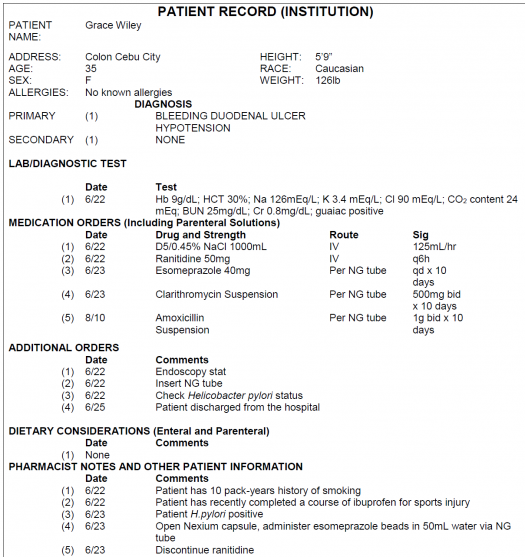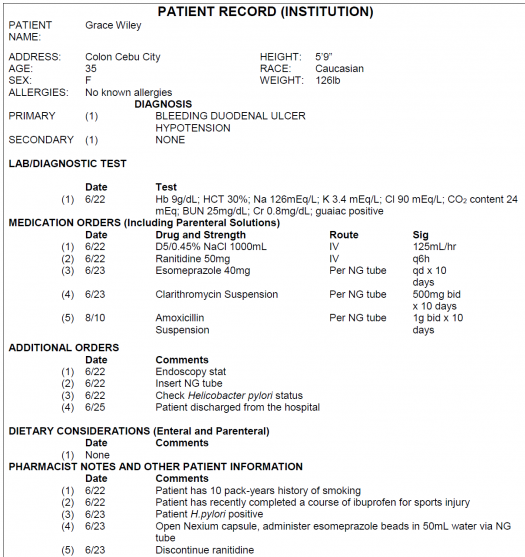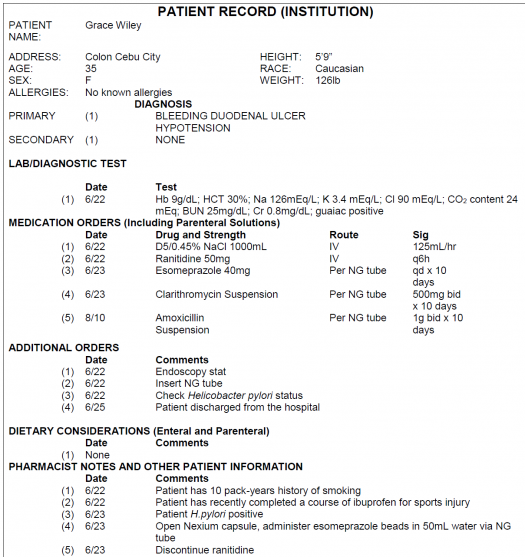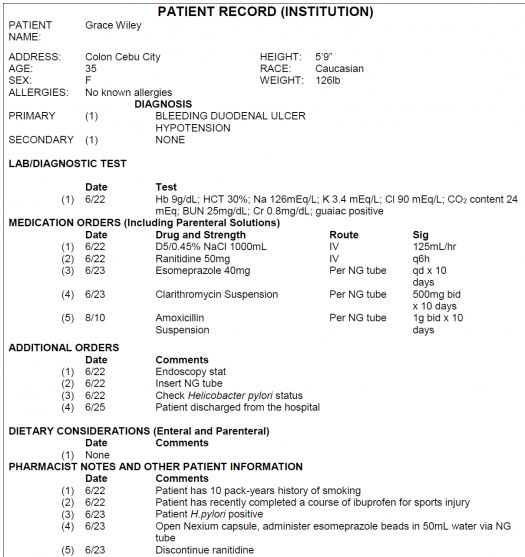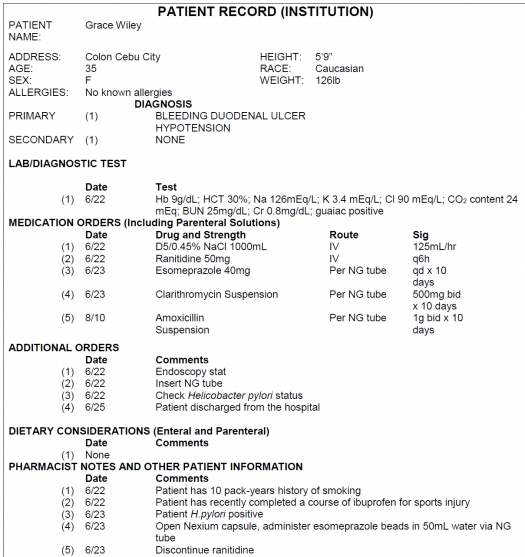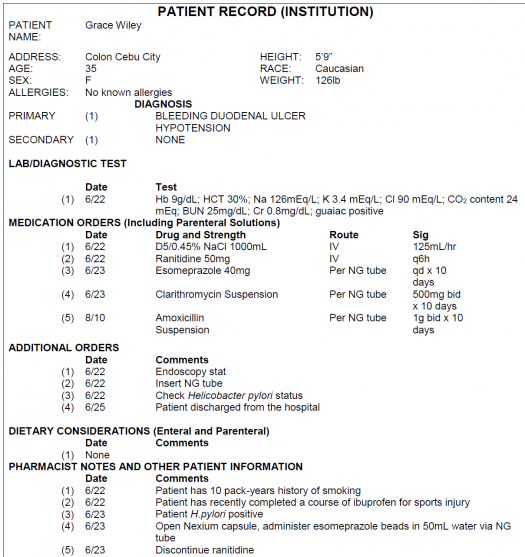Final Exam Pcol1 Tth 1-2:30pm

.
- 1.
As noted in Ms. Wiley’s patient profile, she was tested for H. pylori. Which of the following statements is/are true regarding H. pylori?
- A.
It is present in the majority of patients with duodenal ulcer.
- B.
H. pylori eradication can cure peptic ulcer disease and reduce ulcer recurrence.
- C.
An active duodenal ulcer is best managed with a combination of antisecretory therapy plus appropriate antibiotic(s).
- D.
Option 4
Correct Answer(s)
A. It is present in the majority of patients with duodenal ulcer.
B. H. pylori eradication can cure peptic ulcer disease and reduce ulcer recurrence.
C. An active duodenal ulcer is best managed with a combination of antisecretory therapy plus appropriate antibiotic(s). -
- 2.
In the admission interview, the pharmacist records that the patient has recently completed a regimen of ibuprofen. This information is significant in the patient’s history because (you can tick more than once):
- A.
Ibuprofen may cause ulcers even in H. pylori– negative individuals.
- B.
Ibuprofen may injure the gastric mucosa directly.
- C.
Ibuprofen inhibits synthesis of prostaglandins, thereby compromising the mucosal-protective effect of these substances.
Correct Answer(s)
A. Ibuprofen may cause ulcers even in H. pylori– negative individuals.
B. Ibuprofen may injure the gastric mucosa directly.
C. Ibuprofen inhibits synthesis of prostaglandins, thereby compromising the mucosal-protective effect of these substances. -
- 3.
If Ms. Wiley were allergic to penicillin, what antiinfective agent should be substituted for the amoxicillin?
- A.
Azithromycin
- B.
Cefaclor
- C.
Clindamycin
- D.
Metronidazole
- E.
Vancomycin
Correct Answer
D. Metronidazole -
- 4.
As noted in the profile, Ms. Wiley received ranitidine. The elimination half-life for ranitidine is approximately 2 hours. What percentage of this drug would be eliminated from the body 4 hours after an intravenous (IV) bolus dose?
- A.
12.5%
- B.
25.0%
- C.
50.0%
- D.
75.0%
- E.
87.5%
Correct Answer
D. 75.0% -
- 5.
Ms. Wiley received ranitidine. Of the following H2 antagonists, which one is a particular concern because it interacts with a large number of other medications?
- A.
Ranitidine
- B.
Cimetidine
- C.
Nizatidine
- D.
Famotidine
Correct Answer
B. Cimetidine -
- 6.
All of the following reduce acid secretion by inhibiting the proton pump of the parietal cell except:
- A.
Posaconazole
- B.
Lansoprazole
- C.
Pantoprazole
- D.
Esomeprazole
- E.
Omeprazole
Correct Answer
A. Posaconazole -
- 7.
After leaving the hospital, the patient is given prescriptions for Nexium, amoxicillin, and Biaxin to complete the H. pylori eradication regimen. You should counsel the patient regarding all of the following except which one?
- A.
Refrigerate Biaxin suspension
- B.
Continue Nexium 40 mg for a total of 10 days.
- C.
Clarithromycin can be taken with food to minimize GI side effects.
- D.
Taste disturbances are common with Biaxin.
- E.
Complete a full 10 days of antibiotic/antisecretory therapy for optimal eradication results.
Correct Answer
A. Refrigerate Biaxin suspension -
- 8.
A drug that blocks some or all opioid receptor subtypes.
- A.
Opioid antagonist
- B.
Opiate
- C.
Opioid
- D.
Opioid peptides
Correct Answer
A. Opioid antagonist -
- 9.
A drug derived from alkaloids of the opium poppy.
- A.
Opiate
- B.
Opioid
- C.
Opioid peptides
- D.
Opioid agonist
Correct Answer
A. Opiate -
- 10.
A drug that can activate an opioid receptor to effect a submaximal response
- A.
Partial agonist
- B.
Opiate
- C.
Opioid
- D.
Opioid peptides
Correct Answer
A. Partial agonist -
- 11.
The class of drugs that includes opiates, opiopeptins, and all synthetic and semisynthetic drugs that mimic the actions of the opiates.
- A.
Opioid
- B.
Mixed agonist-antagonist
- C.
Opioid antagonist
- D.
Partial agonist
Correct Answer
A. Opioid -
- 12.
A drug that activates some opioid receptor subtypes and blocks other opioid receptor subtypes
- A.
Mixed agonist-antagonist
- B.
Opioid antagonist
- C.
Partial agonist
- D.
Opioid agonist
Correct Answer
A. Mixed agonist-antagonist -
- 13.
Endogenous peptides that act on opioid receptors.
- A.
Opioid peptides
- B.
Opioid agonist
- C.
Partial agonist
- D.
Opioid antagonist
Correct Answer
A. Opioid peptides -
- 14.
A drug that activates some or all opioid receptor subtypes and does not block any
- A.
Opioid agonist
- B.
Partial agonist
- C.
Opioid antagonist
- D.
Mixed agonist-antagonist
Correct Answer
A. Opioid agonist -
- 15.
This type of opioid receptor plays a major role in the respiratory depressant actions of opioids.
- A.
Mu
- B.
Delta
- C.
Kappa
- D.
Both Mu and Delta
Correct Answer
A. Mu -
- 16.
This/these type of opioid receptor/s is/are involved in slowing GI transit
- A.
Mu
- B.
Delta
- C.
Kappa
- D.
Mu and Delta
- E.
Mu and Kappa
Correct Answer
E. Mu and Kappa -
- 17.
This type of opioid receptor is involved in sedative actions.
- A.
Beta
- B.
Delta
- C.
Kappa
- D.
None of the above
Correct Answer
C. Kappa -
- 18.
This type of opioid receptor is involved in the development of tolerance.
- A.
Kappa
- B.
Mu
- C.
Delta
- D.
Kappa and Mu
Correct Answer
D. Kappa and Mu -
- 19.
Endorphins have highest affinity for _______________ receptors
- A.
Mu
- B.
Kappa
- C.
Delta
- D.
Enkephalins
Correct Answer
A. Mu -
- 20.
Enkephalins have highest affinity for ______________ receptors
- A.
Mu
- B.
Kappa
- C.
Delta
- D.
Beta Endorphins
Correct Answer
C. Delta -
- 21.
Kappa receptors has strong affinities on which Opioid peptide?
- A.
5HT
- B.
Dynorphins
- C.
Beta Endorphins
- D.
Adrenaline
Correct Answer
B. Dynorphins -
- 22.
Inhibitory postsynaptic potential
- A.
Depolarization
- B.
Hyperpolarization
- C.
Repolarization
- D.
Rest
Correct Answer
B. Hyperpolarization -
- 23.
At the presynaptic level, opioid receptor activation can close voltage-gated _____ ion channels to inhibit neurotransmitter release.
- A.
Na+
- B.
K+
- C.
Cl-
- D.
Ca++
Correct Answer
D. Ca++ -
- 24.
The following are acute effects of Opioids except:
- A.
Tolerance
- B.
Analgesia
- C.
Sedation
- D.
Euphoria
- E.
Respiratory Depression
Correct Answer
A. Tolerance -
- 25.
The following are acute effects Opioids except:
- A.
Constipation
- B.
Nausea and Vomiting
- C.
Spasm
- D.
Antitussive
- E.
Dependence
Correct Answer
A. Constipation -
- 26.
Which statement/s is/are TRUE about Opioids causing Respiratory Depression? (you can tick more than once)
- A.
Main action is from the Medulla
- B.
Inhibition of the respiratory center will have decreased response to carbon dioxide challenge.
- C.
Increase partial pressure of CO2 (PCO2) results to an increase in blood flow.
- D.
Increase partial pressure of CO2 (PCO2) results to a decrease intracranial pressure.
- E.
Opioid analgesics are relatively contraindicated in patients with head injuries.
Correct Answer(s)
A. Main action is from the Medulla
B. Inhibition of the respiratory center will have decreased response to carbon dioxide challenge.
C. Increase partial pressure of CO2 (PCO2) results to an increase in blood flow.
E. Opioid analgesics are relatively contraindicated in patients with head injuries. -
- 27.
Clinical Manifestation of Physical Dependence on Opioids
- A.
Rhinorrhea
- B.
Lacrimation
- C.
Chills
- D.
Hostility
- E.
All of the above
Correct Answer
E. All of the above -
- 28.
Duration of action of Fentanyl patches.
- A.
24 hours
- B.
12 hours
- C.
72 hours
- D.
1 week
Correct Answer
C. 72 hours -
- 29.
It used in case of Opioid Dependence
- A.
Methadone
- B.
Fentanyl
- C.
Buprenorphine
- D.
Methadone and Buprenorphine
- E.
Fentanyl and Buprenorphine
Correct Answer
D. Methadone and Buprenorphine -
- 30.
The most appropriate oral medication for his increasing pain is
- A.
Buprenorphine
- B.
Codeine plus aspirin
- C.
Levorphanol
- D.
Pentazocine
- E.
Propoxyphene
Correct Answer
C. Levorphanol -
- 31.
It is possible that this patient will have to increase the dose of the analgesic as his condition progresses as a result of developing tolerance. However, tolerance will not develop to a significant extent with respect to
- A.
Biliary smooth muscle
- B.
Constipation
- C.
Nausea and vomiting
- D.
Sedation
- E.
Urinary retention
Correct Answer
B. Constipation -
- 32.
You are on your way to take an examination and you suddenly get an attack of diarrhea. If you stop at a nearby drugstore for an over-the-counter opioid with antidiarrheal action, you will be asking for
- A.
Codeine
- B.
Dextromethorphan
- C.
Diphenoxylate
- D.
Loperamide
- E.
Tramadol
Correct Answer
D. Loperamide -
- 33.
An emergency department patient with severe pain thought to be of gastrointestinal origin received 80 mg of meperidine. He subsequently developed a severe reaction characterized by tachycardia, hypertension, hyperpyrexia, and seizures. Questioning revealed that the patient had been taking a drug for a psychiatric condition. Which drug is most likely to be responsible for this untoward interaction with meperidine?
- A.
Alprazolam
- B.
Bupropion
- C.
Isocarboxazid
- D.
Lithium
- E.
Mirtazapine
Correct Answer
C. Isocarboxazid -
- 34.
Genetic polymorphisms in certain hepatic enzymes involved in drug metabolism are established to be responsible for variations in analgesic response to
- A.
Codeine
- B.
Fentanyl
- C.
Meperidine
- D.
Methadone
- E.
Tramadol
Correct Answer
A. Codeine -
- 35.
Case: A young male patient is brought to the emergency department in an anxious and agitated state. He informs the attending physician that he uses “street drugs” and that he gave himself an intravenous “fix” approximately 12 h ago. He now has chills and muscle aches and has also been vomiting. His symptoms include hyperventilation and hyperthermia. The attending physician notes that his pupil size is larger than normal. What is the most likely cause of these signs and symptoms?
- A.
The patient had injected methamphetamine
- B.
The patient has hepatitis B
- C.
The patient has overdosed with an opioid
- D.
The signs and symptoms are those of the opioid abstinence syndrome
- E.
These are early signs of toxicity due to contaminants in “street heroin”
Correct Answer
D. The signs and symptoms are those of the opioid abstinence syndrome -
- 36.
Case: A young male patient is brought to the emergency department in an anxious and agitated state. He informs the attending physician that he uses “street drugs” and that he gave himself an intravenous “fix” approximately 12 h ago. He now has chills and muscle aches and has also been vomiting. His symptoms include hyperventilation and hyperthermia. The attending physician notes that his pupil size is larger than normal. Which drug will be most effective in alleviating the symptoms experienced by this patient?
- A.
Acetaminophen
- B.
Codeine
- C.
Diazepam
- D.
Methadone
- E.
Naltrexone
Correct Answer
D. Methadone -
- 37.
Which statement about butorphanol is accurate?
- A.
Activates μ receptors
- B.
Does not cause respiratory depression
- C.
Is a nonsedating opioid
- D.
Pain-relieving action is not superior to that of codeine
- E.
Response to naloxone in overdose may be unreliable
Correct Answer
E. Response to naloxone in overdose may be unreliable -
- 38.
Which drug does not activate opioid receptors, has been proposed as a maintenance drug in treatment programs for opioid addicts, and with a single oral dose, will block the effects of injected heroin for up to 48 h?
- A.
Amphetamine
- B.
Buprenorphine
- C.
Naloxone
- D.
Naltrexone
- E.
Propoxyphene
Correct Answer
D. Naltrexone -
- 39.
Which statement about dextromethorphan is accurate?
- A.
Activates κ receptors
- B.
Analgesia equivalent to pentazocine
- C.
Highly effective antiemetic
- D.
Less constipation than codeine
- E.
No abuse potential
Correct Answer
D. Less constipation than codeine -
- 40.
Tramadol
- A.
Strong agonist
- B.
Partial agonist
- C.
Mixed agonist-antagonist
- D.
Antagonist
- E.
Antitussives
Correct Answer
E. Antitussives -
- 41.
Codeine
- A.
Strong agonist
- B.
Partial agonist
- C.
Mixed agonist-antagonist
- D.
Antagonist
Correct Answer
B. Partial agonist -
- 42.
Fentanyl
- A.
Strong agonist
- B.
Partial agonist
- C.
Antagonist
- D.
Antitussives
Correct Answer
A. Strong agonist -
- 43.
Hydrocodone
- A.
Strong agonist
- B.
Partial agonist
- C.
Mixed agonist-antagonist
- D.
Antagonist
Correct Answer
B. Partial agonist -
- 44.
Naloxone
- A.
Strong agonist
- B.
Partial agonist
- C.
Mixed agonist-antagonist
- D.
Antagonist
Correct Answer
D. Antagonist -
- 45.
Buprenorphine
- A.
Strong agonist
- B.
Partial agonist
- C.
Mixed agonist-antagonist
- D.
Antagonist
Correct Answer
C. Mixed agonist-antagonist -
- 46.
Naltrexone
- A.
Strong agonist
- B.
Partial gonist
- C.
Mixed agonist-antagonist
- D.
Antagonist
Correct Answer
D. Antagonist -
- 47.
Hydromorphone
- A.
Strong agonist
- B.
Partial agonist
- C.
Mixed agonist-antagonist
- D.
Antagonist
Correct Answer
A. Strong agonist -
- 48.
Dextromethorphan
- A.
Strong agonist
- B.
Partial agonist
- C.
Expectorant
- D.
Antitussives
Correct Answer
D. Antitussives -
- 49.
Nalbuphine
- A.
Strong agonist
- B.
Partial agonist
- C.
Mixed agonist-antagonist
- D.
Antagonist
Correct Answer
C. Mixed agonist-antagonist -
- 50.
Meperidine
- A.
Strong agonist
- B.
Partial agonist
- C.
Mixed agonist-antagonist
- D.
Antagonist
Correct Answer
A. Strong agonist -
Quiz Review Timeline +
Our quizzes are rigorously reviewed, monitored and continuously updated by our expert board to maintain accuracy, relevance, and timeliness.
-
Current Version
-
Mar 21, 2022Quiz Edited by
ProProfs Editorial Team -
Mar 21, 2020Quiz Created by
Jacky
 Back to top
Back to top




